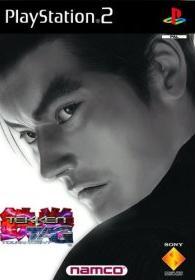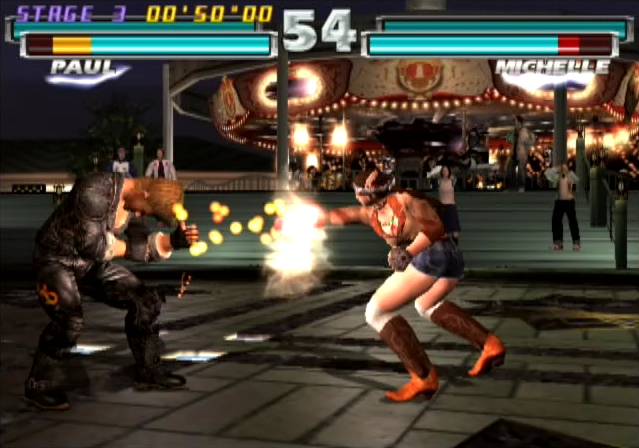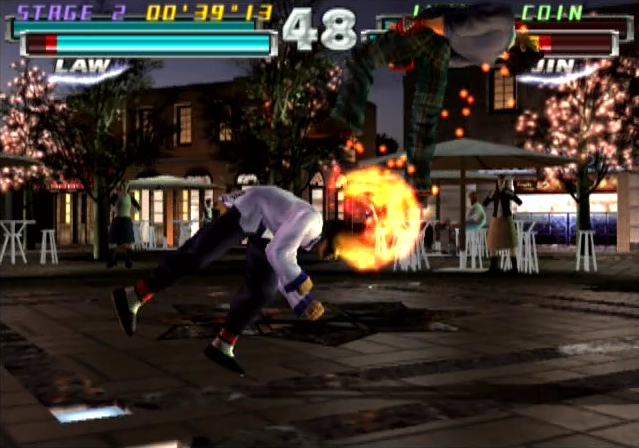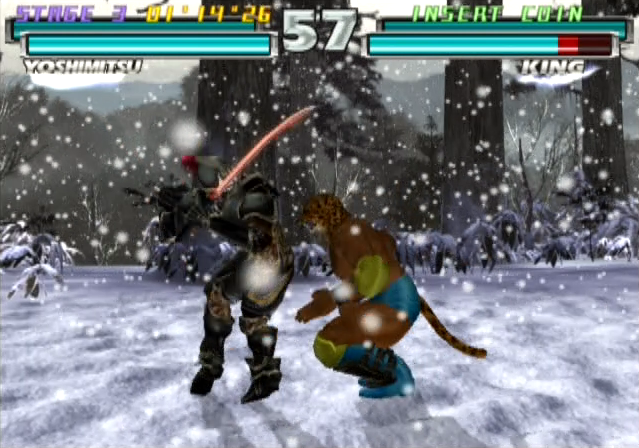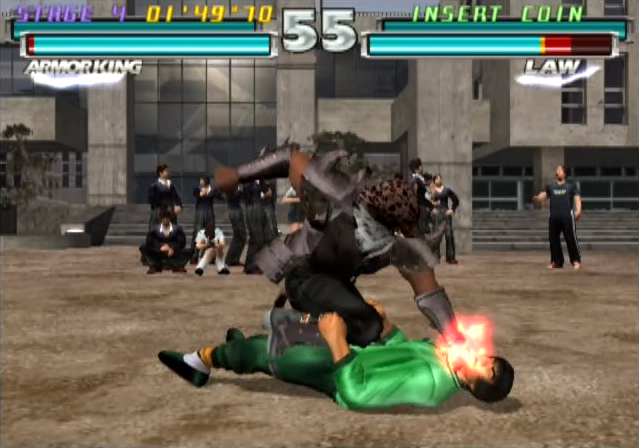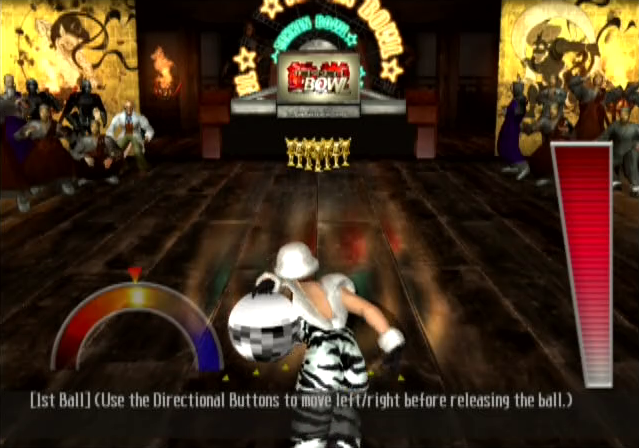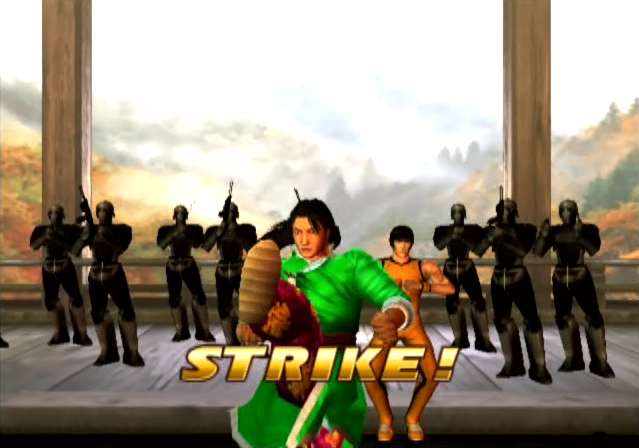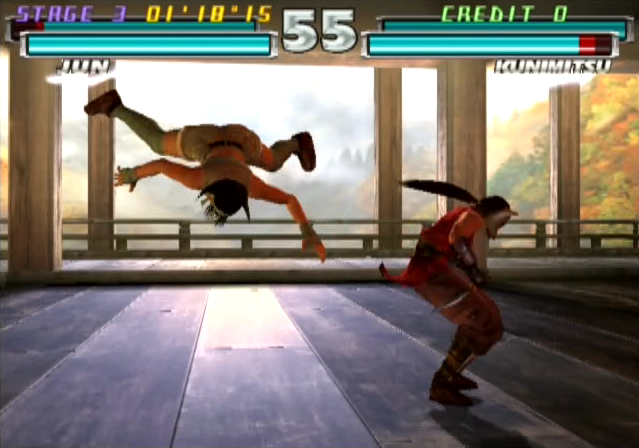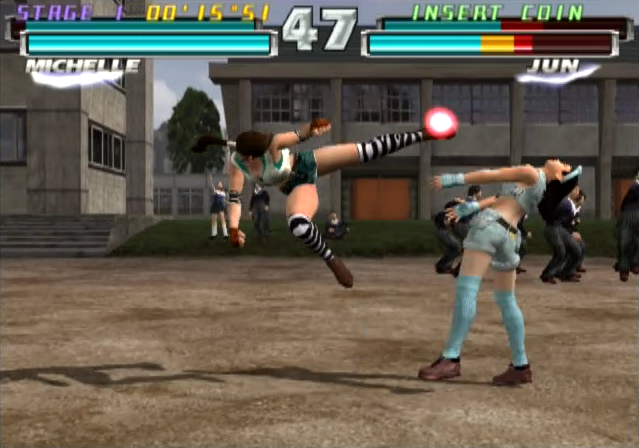TEKKEN TAG TOURNAMENT (PS2)
At a cursory glance, Tekken Tag Tournament seemed to sit at the safer end of the PlayStation 2’s launch options. An entirely familiar roster of characters and a single, novel new fight mechanic appeared to place Namco’s brawler in tech showpiece territory. However, with TimeSplitters slipping under the radar (at least to begin with), Ridge Racer V proving a step backwards from its illustrious predecessors and Smuggler’s Run dividing opinion amongst early adopters, TTT emerged as the clear favourite from the PS2’s initial output.
With good reason, too. It’s a brilliant beat ‘em up. By 2000, it’s fair to say the “arcade perfect” aspirational phrase had long-since been retired, but it bears remembering in relation to Tekken Tag Tournament. After all, the fourth game in the series, like all the others, had started life as a coin-op. TTT’s greatest strength, in conjunction with the wow-factor of the new format’s capabilities, is that it translates the “big experience” of the arcades into the home setting.
Tekken Tag Tournament shows the PlayStation 2 off in all the right ways: it looks incredible, and plays like a dream
It’s all about impact. The lavish, exciting intro video builds expectation. This is followed swiftly by dynamic colourful menu screens, where each affirmative selection is met with a percussive punch, a lightning-bolt of pure energy. Pulsating, adrenalin-charged character select music and the vaguely-digitised, showtime proclamations of the American announcer positively boom from your TV. Jumping straight from the original PlayStation to be met with this cacophony, this bombastic assault on the senses, is utterly thrilling.
These excellent first impressions carry ably into the gameplay. Every one of the fighters looks incredible, as despite a mind-boggling variety of character builds and fighting styles, it never puts a foot wrong. To feature such flawless, high-quality animation is a real rarity amongst launch titles when most developers are still exploring the technical limits of the hardware. There’s none of the angular awkwardness of the PlayStation pugilists, it’s all fluidity and grace. The backgrounds are on another level too. Huge 3D spaces house an elaborate range of scenes. There’s Ling Xiaoyu’s bustling schoolyard, to the complete opposite end of the scale, a tranquil, isolated dojo with rays of sunshine brushing the ground around which you fight. There’s lively nighttime carnivals, as well as forests amid blizzards of snow, which are simply breathtaking. This, Namco was proclaiming, is a glimpse of what your PlayStation 2 might be capable of.
These excellent first impressions carry ably into the gameplay. Every one of the fighters looks incredible, as despite a mind-boggling variety of character builds and fighting styles, it never puts a foot wrong. To feature such flawless, high-quality animation is a real rarity amongst launch titles when most developers are still exploring the technical limits of the hardware. There’s none of the angular awkwardness of the PlayStation pugilists, it’s all fluidity and grace. The backgrounds are on another level too. Huge 3D spaces house an elaborate range of scenes. There’s Ling Xiaoyu’s bustling schoolyard, to the complete opposite end of the scale, a tranquil, isolated dojo with rays of sunshine brushing the ground around which you fight. There’s lively nighttime carnivals, as well as forests amid blizzards of snow, which are simply breathtaking. This, Namco was proclaiming, is a glimpse of what your PlayStation 2 might be capable of.
The character roster is a huge selling point. As well as featuring more or less every character to have appeared in Tekken 3 (a good start), the icing of the cake is the return of a host of figures who seemingly died or went missing during the events of Tekken 2. This means a return for some legendary brawlers, including kick-sensation Baek, unorthodox ninja Kunimitsu and the martyred mother of Jin, Jun Kazama. With these and a few others besides not featuring in Tekken 3, it’s fantastic not only to see them reprising their roles but also to witness just how neatly these revamped fighters fit in. Granted, there’s an argument for saying that three separate versions of Jack, the robot juggernaut, is perhaps over-egging the pudding, but it marked what was Tekken’s broadest and best line-up to date.
Which brings us to Tekken Tag Tournament’s key new feature: its tag system. It’s one single, new idea, but it transforms things. Each tag fight features two characters on each side, with the shoulder buttons allowing for a smooth tag motion. Timing is key to using it effectively; knowing when you’re on the ropes, picking the right moment to roll out of danger and indeed, avoiding tagging your partner in at the point where they run straight into Paul Phoenix’s burning fist. It’s a nuanced system but it’s the smooth, uncomplicated nature that makes it work so well. Brawlers can even deliver double-team manoeuvres with a well-timed tag during a throw.
Which brings us to Tekken Tag Tournament’s key new feature: its tag system. It’s one single, new idea, but it transforms things. Each tag fight features two characters on each side, with the shoulder buttons allowing for a smooth tag motion. Timing is key to using it effectively; knowing when you’re on the ropes, picking the right moment to roll out of danger and indeed, avoiding tagging your partner in at the point where they run straight into Paul Phoenix’s burning fist. It’s a nuanced system but it’s the smooth, uncomplicated nature that makes it work so well. Brawlers can even deliver double-team manoeuvres with a well-timed tag during a throw.
FOCAL POINT: TEKKEN BOWL
By the time Tekken Tag Tournament arrived on the scene, the series had become somewhat renowned for its weird ‘n’ wacky unlockable modes, which had previously included a roaming beat ‘em up and the beach volleyball (volleybrawl?) madness that was Tekken Ball. Namco outdid themselves with Tekken Bowl, however, a mode that unlocks once you’ve completed Arcade mode ten times. This went much further than the two aforementioned novelties though. It’s no exaggeration to say that The King of Ironbowl is better than most standalone ten-pin bowling efforts. It’s fast, nippy to control, incredibly accessible and a great deal of fun. There’s a host of neat little touches to discover, from the variety of wacky celebrations to the recognition of some fighters bowling with their left hand. The likes of Bryan, P-Jack and Yoshimitsu feature a variety of cybernetic, head-up displays. As you’d expect, robots and brutes offer power at the cost of accuracy, though there’s plenty of all-rounders and indeed characters with less strength but easier aiming options. You can play with or against a friend and there’s even an additional Jukebox to unlock, should you manage a score of 200 or more in a single game. Against all expectations, it’s incredibly moreish, and likely the best additional game mode ever to have appeared in a Tekken game.
In terms of game modes, things are predictably well-catered for. Evergreen, endlessly playable Tekken mainstays Arcade, Time Attack, Team Battle and Survival are all present and correct, but thanks to the two-vs-two match-ups, you’ll find a new dimension to all of them. Tactically, you’ll have to judge when to swap out and protect a wounded fighter in Survival, where fighters regain a portion of lost health upon victory. Alternatively, Team Battle may see you choosing to sacrifice a weaker character who is low on health, to keep your most potent one in the frame for later bouts. There’s also a One-On-One mode for those who fancy a combat experience more in keeping with the earlier games, so everyone’s catered for. TTT offers one entirely new mode, the hugely playable, immensely addictive Tekken Bowl. This ten-pin bowling mini-game can be enjoyed cooperatively or competitively with a friend, and it’s an absolute riot.
For a launch title, Tekken Tag Tournament feels like it’s on a remarkably solid technical standing. That should perhaps come as no surprise, given how good Tekken 3 was before it. There’s only one genuine complaint beyond what could be seen as mere nit-picking. One of the series’ greatest draws has always been its ending movies, the reward for completing the Arcade mode with a given fighter. After a storming opening FMV, you’re itching to blast through Arcade mode, to see what lavish action sequence lies in wait for your character of choice. Unfortunately, the endings are something of a non-entity. They’re all very short, use in the in-game engine, feature no dialogue and all come with the same weirdly incongruous background music. A significant number of endings simply show characters sat next to each other or gesticulating with little purpose. In truth, the Theatre feels more like a glorified costume viewer.
For a launch title, Tekken Tag Tournament feels like it’s on a remarkably solid technical standing. That should perhaps come as no surprise, given how good Tekken 3 was before it. There’s only one genuine complaint beyond what could be seen as mere nit-picking. One of the series’ greatest draws has always been its ending movies, the reward for completing the Arcade mode with a given fighter. After a storming opening FMV, you’re itching to blast through Arcade mode, to see what lavish action sequence lies in wait for your character of choice. Unfortunately, the endings are something of a non-entity. They’re all very short, use in the in-game engine, feature no dialogue and all come with the same weirdly incongruous background music. A significant number of endings simply show characters sat next to each other or gesticulating with little purpose. In truth, the Theatre feels more like a glorified costume viewer.
Characters presumed dead or missing at the end of Tekken 2 return for Tag Tournament, and fit in brilliantly
Nevertheless, the game play’s so well that it’s unlikely to prove much of a sticking point. After all, Tekken Tag Tournament was the game to wow your friends, the game to say “this is what my new console can do, this is what we have to look forward to”. But it’s more than that. It’s a game that has aged with supreme grace, something that is especially rare among launch titles often intended as creative launch pads rather than legacy titles in their own right. When Tekken 4 stripped down the roster to the consternation of fans, it served as a reminder of the formidable benchmark by which the series was to be judged: not only in relation to Tekken 3, but to Tekken Tag Tournament as well. What seemed at first glance like an exciting technical revamp has, thanks to its unerring quality and a fantastic tag mechanic, come to stand as an essential beat ‘em up on its own terms, and one of the greats of its genre.
|
|
VERDICT
"What seemed at first glance like an exciting technical revamp has, thanks to its unerring quality and a fantastic tag mechanic, come to count as an essential fighter on its own terms, and stands as one of the greats of its genre." OVERALL: 9/10 |
